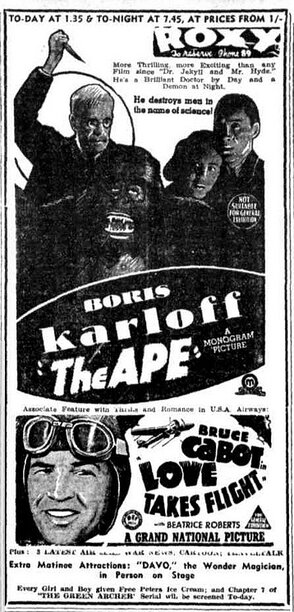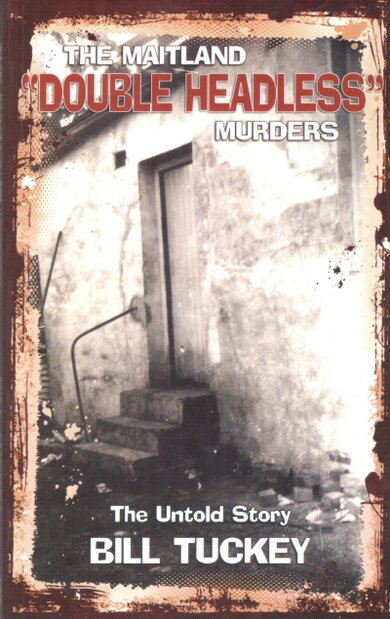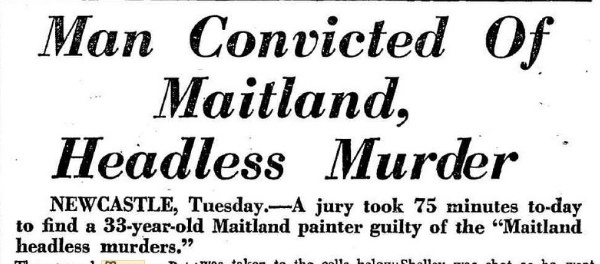Murder of Davo the Magician
Davo the magician was murdered in Queensland in 1941. It was a brutal murder, committed by a teenage boy already on his way to becoming an incorrigible criminal.
But Davo’s murder was only the start. There was much, much worse to come.
Because this site concerns itself with stories of magicians, we focus here on the story of Christian Watkins, “Davo”. The end of the story has already been well documented in a 2009 book by Bill Tuckey, so we will give only the outline of the gruesome facts, and point readers to the more detailed source.
Christian A. Watkins – Davo the Magician
Christian Watkins seems to have been a journeyman magician in the Eastern Queensland area, travelling around and making his living by entertaining children. He was not especially famous but seems to have been a familiar figure in his region. We assume his name, “Davo”, was pronounced Dave-O in the style, familiar to every Australian, of putting an O on the end of a name to indicate a casual friendly type of person; though a couple of newspaper reports referred to him as “Darvo”.

Christian Watkins - Davo
February 1933 – Davo was a Children’s Entertainer at ‘Saturday Morning Parties’ hosted by Radio 4BH Brisbane on a number of occasions.
January 5 1934 – [Telegraph, Brisbane] – Davo advertised for a young offsider:
‘OPPORTUNITY learn congenial profession, Magician Davo, touring State, has vacancy lad 16, only interest; call 71 Wharf Street’.
December 1937 – Seeking £200 damages after being hit by a car, Davo claimed he was unable to perform one of his important escape tricks – the bag escape, and had an injury to the index finger of left hand that hampered him in his sleight of hand. He was awarded £64. The reports called him a ‘Conjurer and professional entertainer of Addison Street, Red Hill’. He would be involved in another court dispute at Nambour in 1939, in which two vehicles collided and Watkins was found to be at fault.
February 1939 – His sleight of hand “amazed his youthful audience” at Prenzlau.
June 1939 – Tamborine QLD – “The children of the local State School were given an enjoyable and interesting entertainment at the school on Monday, by Davo the Magician, who visits the schools periodically under permit from the Department of Education.”
August 31 1940 – Davo appeared at the Roxy Theatre, Townsville with a movie bill – “comes with a reputation that has put him in the front rank of showmen.”

Davo advert, January 6, 1933
April 1 1941 – Fundraiser at the Boonah School of Arts for the Boonah School. “Notable being the inclusion of ‘Davo’ the magician, who kept the people highly entertained.”
Murder at Cape Pallarenda

On the day of Saturday August 9, 1941, Davo was advertised to be performing in conjunction with the Boris Karloff movie, “The Ape” at the Townsville Roxy theatre. Also in Townsville, at the Theatre Royal, was Les Cole, The Great Levante. On the Monday he was seen travelling in a sedan car, accompanied by a youth whom he employed.
Just a few days later, on August 12, the body of Watkins was discovered by children, lying off the road at Cape Pallarenda. He was covered with an overcoat, and his head had been staved in, with multiple gashes to the skull.
Within days, police apprehended two males sleeping in Watkins’ car – James Anderson, and a young man who identified himself as Harry Lambert, aged 18. A bloodstained axe was found in the car.
Lambert, who initially said that his mother had died when he was young, denied any knowledge of the murder, said he had not been near Pallarenda and claimed that he was driving the car up to Cardwell, where he was to meet with his employer, Watkins. As soon as he was advised that a witness had seen him driving, at speed, at Pallarenda, ‘Lambert’ caved in and said “I did it … I will have to pay for it.”
The truth behind many of the statements made, by both ‘Lambert’ and Andersen, is difficult to resolve. While both would later make accusations against Watkins to the effect that he had intended to molest Lambert, that claim should be weighed against the veracity of the accusers.Davo 1941 Aug 9 last advert
As originally presented to the Townsville magistrate in early September, Lambert said that he had joined up with Watkins a month previously and they had had a number of arguments; Watkins saying (according to Lambert) that he had a paper giving him ‘control’ of Lambert until he was 21.
While camped at Pallarenda, Watkins was about to cook some sausages in a frying pan, when Lambert hit him with a tomahawk several times, dragged the body some distance away and then, finding that his heart was still beating, hit him again. He had met up with James Anderson who had gone with him in the car.
Though Lambert claimed Watkins had wanted to sleep with him, when Senior Sergeant Voight asked if he had ever made an improper suggestion to him, Lambert said “No.”. He admitted taking a purse with a few pounds in it, and a watch and notebook.
James Anderson, for his part, said that he had met Lambert some time ago in Newcastle, that they came north together to Gordonvale and then parted. Later he saw Lambert in Townsville and they had several conversations, and Lambert had pulled up beside him one day and said “jump in”, whereupon they travelled to Cardwell.
Evidence was given that Anderson believed Christian Watkins was a ‘sexual pervert’ and had formed that opinion from information given to him by the friend of a boy who had once worked for Watkins. The suggestion was that Anderson tried to convince Harry Lambert that he was a ‘prisoner’ and should break away and travel north with him. The magistrate stated outright that Anderson was a mischief maker, implicitly accusing him of encouraging the murder, but Anderson hotly denied that he was trying to cause trouble.
An inspector of fisheries, William Hidding, gave evidence that he had met Watkins and Lambert just a week before the murder, and that “Davo” had made a remark about leaving all his belongings, worth about £500 to Lambert in his will, if he proved a decent and reliable assistant. Davo, he said, was a most respectable old fellow.
The magistrate at the hearing said that he was more than satisfied that Anderson had set Lambert against his employer and made him unhappy.
Early History of Eric Bowles, a.k.a. Harry Lambert
It did not take long for police to start unravelling the origins of “Harry Lambert”. Somehow they managed to learn that he was, in fact, a fourteen-year old named Eric Francis Bowles, born on January 27, 1927 to a stable family life in Carlton, NSW where he attended the local Marist Brothers’ school. His mother, contrary to previous statements, was still alive.
Bowles had good reason for adopting a new name in Queensland – he had plenty of legal history in New South Wales to conceal, breaking into a Rockdale cinema and a house, and destroying stock in a produce store. The Children’s Court, listening to seven charges of stealing against him, had bound Bowles over to his father’s custody, but in early 1941 he had again been caught, this time stealing a woman’s handbag; he ran away after stealing money from his mother and headed for Newcastle.

It was here that he first met up with James Anderson and they jumped a train for Cardwell in Queensland before separating, Bowles then drifting around the state. At Gordonvale, he was caught after breaking into the railway station and stealing fifteen shillings; he was sentenced to fourteen days in gaol. Not long afterwards he broke into a house at Cairns to steal goods worth about £45, and at Ravenshoe he was caught stealing five shillings.
Bowles was noticed by Christian ‘Davo’ Watkins at the courthouse. He paid his fine and gave him a job. Whether he had any form of custody arrangement is unclear.
Bowles would write to his mother in October 1941, relating his history to date and writing, “I killed him and took his money and his car. So it is no use you worrying about me and spending your money and coming up because if you come up I will do my best to get sent to prison as I am not sorry for anything I have done.”
Final Sentencing
The trial of Bowles commenced on December 1. It seems that Anderson had escaped any entanglement in the case. Speaking from the box, Bowles now said that Christian Watkins had made improper suggestions to him and, following an attack, he had struck Watkins on the head. The previous statement he made to the police, he said, was all lies.
Mr. Justice R.J. Douglas of the Supreme Court, received a verdict of ‘guilty of manslaughter’ from the jury. He told Bowles, “In its verdict the jury has evidently considered that there was some provocation. Your previous actions show that you should be restrained. You have had good education, are an intelligent boy, and have a good father and mother. You got into bad company and started petty thieving. When discovered you were committed to the care of your father who did his best, but you soon ran away from home and committed a series of thefts in Queensland. Nevertheless, it is quite possible and quite likely that you can yet become a good citizen, but you must be shown that you have to obey the laws.” He sentenced Eric Bowles to be detained until he reached the age of eighteen.
Bowles’ History Continues
There, the matter of Davo the Magician ended. His estate was sold at auction in Townsville on February 13, 1942, including conjurer’s apparatus, camp bedding and fishing gear.
Eric Francis Bowles was released after Christmas 1944 and headed back to New South Wales. It was not long before he was again in trouble, going by this list of charges found in the newspapers:-
July 1945 – Break and enter to the home of F.Tindal at Newcastle, stealing a rifle and other articles. (Bowles was noted as a ‘labourer’).
February 1946 – Theft of £10, the property of Broken Hill Pty. Co. by fraudulently cashing in another man’s pay docket.
July 1946 – Theft of two cars in company with another male and a female, one at Casino and another at Murwillumbah along with more than one hundred other items of property. Bowles was also remanded to Newcastle on a separate charge of stealing goods from Scotts Pty Ltd. to the value of £170.
On the car theft charges, Bowles was sentenced to two and a half years gaol. He made the telling statement that by his theft he had gained £100 which he had spent within a week; and argued that the ordinary honest working man would work three years to earn the same amount. He said that, if he was given three years for the offences, he would be no further behind than the honest man who had worked for three years.
March 1951 – Remanded on £100 bail on a charge of breaking, entering and stealing a wedding ring and other items from a house in Newcastle. Sentencing him to three year’s imprisonment, the magistrate said “You have a shocking record. If you come before me again I will declare you an habitual criminal.”
He was already that. Bill Tuckey’s book states that the Sydney CIB register had him listed as “an active and incorrigible criminal, arsonist, car and bicycle thief, house and shop-breaker and murderer.” He also relates a case (1) in the 1950s where Bowles was discovered breaking into a house in the Newcastle suburb of Hamilton, attacking the male of the house and bashing the man’s wife with a tyre lever. He was given six years in Maitland Gaol, ultimately being released in November 1959.
At this stage, we will revert to giving just the outline of the horrific story which was to follow. Journalist and motoring writer, Bill Tuckey, has already written a full book encompassing in-depth details of the case, the surrounding social history of the times, and some concerns over missed questions and opportunities. For a comprehensive coverage of this story, Tuckey’s book is the source to read. (2)
Final Chapter in Maitland
Sydney Silvester Shelley, his wife Elva Elaine Shelley and their eight-month old baby daughter lived in a modest cottage in East Maitland. On April 23, 1960, news broke of a most appalling murder of the husband and wife, both of whom were found dead in the house , and decapitated by some form of sharp blade; the heads were nowhere to be found. The baby girl was found covered with a blanket and cardboard box and nearly smothered; possibly indicating that the mother had tried to hide her before she was killed. Mrs. Shelley was also three months pregnant.
The investigating office, Ted Cahill would later describe the killings as “the most bloodthirsty, cold, calculated, premeditated murder I have ever known.”
Initially, the police struggled to find leads. The severed heads were missing, no weapons were found, and no apparent motive was known. By a number of lucky chances it was not long before things started to fall in place.
On the Silo Wharf at Newcastle Harbour, fisherman Stanley Ramsden noticed what he thought was a cabbage floating in the murky water; it turned out to be the head of Mrs. Elva Shelley and was identified by hair samples. Upon closer examination, two bullets were retrieved from the head, showing that the Shelleys had been shot first, then beheaded.

Sydney Shelley was known to have owned an old gun, and it was discovered that he had lent it to a friend, a man by the name of Jack Vile Russell. From Russell the investigators learned that a number of practice shots had been fired into a wooden post at the Shelley’s home, at the time Russell borrowed the gun; and those slugs were retrieved.
From Jack Russell, it was a fast leap to a connection with a man who was going under the name of Terrence Patrick O’Connor. Russell and O’Connor had been planning an armed holdup in Newcastle using the gun to intimidate their victims.
But O’Connor had another secret. His real name was Eric Francis Bowles, the killer of Davo the magician. Under immediate suspicion, both Russell and Bowles were interviewed separately in an attempt to find discrepancies in their stories. Each would give stories and excuses which served to confuse the case (the gun was claimed to have been tossed by Bowles into the harbour off Nobby’s Head) but ultimately the pair were set against each other and made counter-claims of the other’s guilt. O’Connor gave a story that Mrs. Shelley’s unborn baby was in fact the child of Jack Russell, and that Russell had killed her to avoid being found out.
The gun, the blade, and Sydney Shelley’s head were never recovered, and the true motive for the murders was not learned, but with forensic comparison of the bullets recovered from Mrs Shelley and the wooden post, ultimately a case was built sufficient to charge Bowles/O’Connor with murder.
In Bill Tuckey’s book the author poses some questions about parts of the investigation which were poorly carried out and not properly examined. He raises the real possibility that both Russell and Bowles might have acted together. However, as events turned out, Russell escaped trial.

At the end of August 1960, Eric Francis Bowles, under the name Terrence O’Connor, was convicted by a Newcastle jury of murder. He was sentenced to life in prison and, if he is still alive, his whereabouts are unknown.
Author, Bill Tuckey sums up the life of Eric Bowles as “a cruel, chronic liar, contemptuous of human life, a compulsive thief, a cynical manipulator of women and a murderer who didn’t belong in decent society.”
REFERENCES
(1) I am not able to verify this instance via online newspaper reports, however at the time of writing, Sydney Morning Herald, Newcastle Herald and Maitland Mercury newspapers are not digitised in Trove past 1954.
(2) For the detailed story of the Maitland killings, see The Maitland “Double Headless” Murders by Bill Tuckey. Bas Publishing, 2009, ISBN 97819214906059 (paperback). Image of Bowles (above) is reproduced from the book.